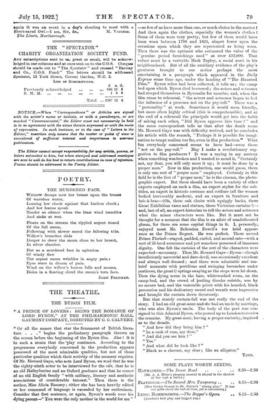THE SHORT-EARED OWL..
[To TELE EDITOR or THE " SPECTATOR."].
quite agree with. your contributor that the Short-eared. Owl is "worth hearing more about," so perhaps you will allow• me to supplement. his interesting_ article-. with a :few additional facts. It is probable that few of your readers: are aware that. this bird is perhaps. the most useful of its genus, and. still fewer that it hunts in the daylight. and makes. its nest on the ground in the sedges,. the heather, or- the bracken. As a winter migrant it is. a.. well-known visitor to many parts_ of East: Anglia, the South of England, and especially Devon, but, as a.reeident„ it is:now very-rareimEngland. and far from, common. in Scotland. It was the- draining of the fens. and the breaking up- of the commons that. banished this bird and the Harriers from- their ancient haunts, and_ since that time. there are very few. records. of its: aving: nested: in East Anglia, though. one or two pairs have found a. refuge in Wickert Fen,. the only- piece of the old Fen. land that. remains, untouched. by- the. hand of man. From what your contributor- tells us„ it is. just possible, that this- species. may, like, the. Redshank, be gradually extending. its breeding. range, but its visits are so irregular that- it is, bee. early at present to speak. with any: degree. of certainty. I, can. well remember the-intense. pleasure with. which watched the Hen Harrier and the Short-eared Owl in the. Orkneys more than forty years. ago, the. Owl hovering - over its neat and_ the. Harrier quartering the ground with the regularity of- a. pointer. Even in those days both species-were- decreasing owing to the depredations, of the egg collectors, who robbed the nests of our rarer birds. to enrich the cabinets of unscrupulous_ naturalists. That a few. pairs- survive in. Orkney to this day. is due to the- efforts of the R.S.P.B. There is no better place, for watching these birds in the breeding season. than the.sand hills of Texel, where they are strictly protected. by the Dutch Government, which co-operates vigorously with. a. private society in preserving for the enjoyment of future generations birds like the Ruff and the Avocet,. which, we have lost for ever. The. bird-at times. strongly resents its privacy being intruded on. When. Professor. Newton was_ one day searching for a nest. he was astonished by the fierceness of the- parent bird; which swooped down on. him and threatened his dog, and, a frien.d,of mine had his first attempt. to. take a. photo: frustrated by the repeated attacks. which- were made on his camera. The- second attempt was. more successful, and I possess an admirable photo of an owl on its. nest to remind me- of my- visits to the eandalunes- of Texel. Just before the immigration of the Woodcock occurs, many: of these birds- find their. way from Scandinavia to the East Coast- with such punctuality • that: they- are called Wood-, cock Owls, for.the same reason that the Golden, Crested Wren. is known as the Woodcock-pilot. As a destroyer of mite-and voles this bird has few_ rivals. The- late- John Cordeaux tells us that a solitary owl stayed- in a ricky-ard all through the winter, and such a clean. sweep did: it- make of the mice that his bailiff considered. the bird " far before; any me•" r was lucky enough to witness-, an exhibition: of its; beneficent_ activities on a wider scale It was my good fortune! from_ 1890- to 1913 to shoot in the beautiful country between_ the. upper reaches. of. the- Ettrick: and Yarrow, the, highest beat, of the-shoot commanding; aglorion.s view-of.- St.. Mary's Loch.. It is a. feature of the. locality that. there- is alkaost: as: mach grass as heather: on the- hills,. which afford: excellent pasturage,' for sheep. In, the first year. it wae:an event in taday's shooting te- see a. Shertae,ared Owl. Then in 1831 came the terrible; invasion of: voles which destroyed. all the gram: some of the hills: being. as bare a& the high road.. When the farmers-were: in despair there came a " benign: invasion."' of: Shorboar.ect Owlet No hill was. without:a pair,, and so.well did: the invaders thrive, on a diet of voles: that some nests: contained., from seven to. twelve- eggs- instead of five, and some- eases.: tame broods were reared instead of one. In two years the plague was stayed, and a Royal Commission, which waainvoetigatiag the cause of this, plague, admitted, that if it had: not: been, for.- the.. owle the sheep-farmers of the Border might-. have. fund' theit occupation, gone. Their- work done the owls: disappeared,, and:. again it was an event in a day's shooting to meet with a short-eared Owl.—I am, Sir, &a., If. VaROHAN. 2'he Limes, Marlborough,.



































 Previous page
Previous page